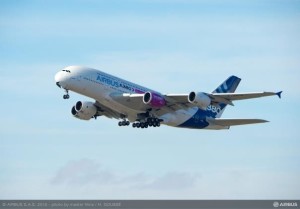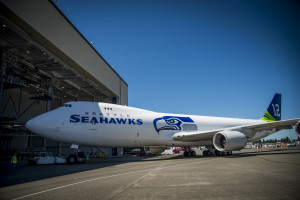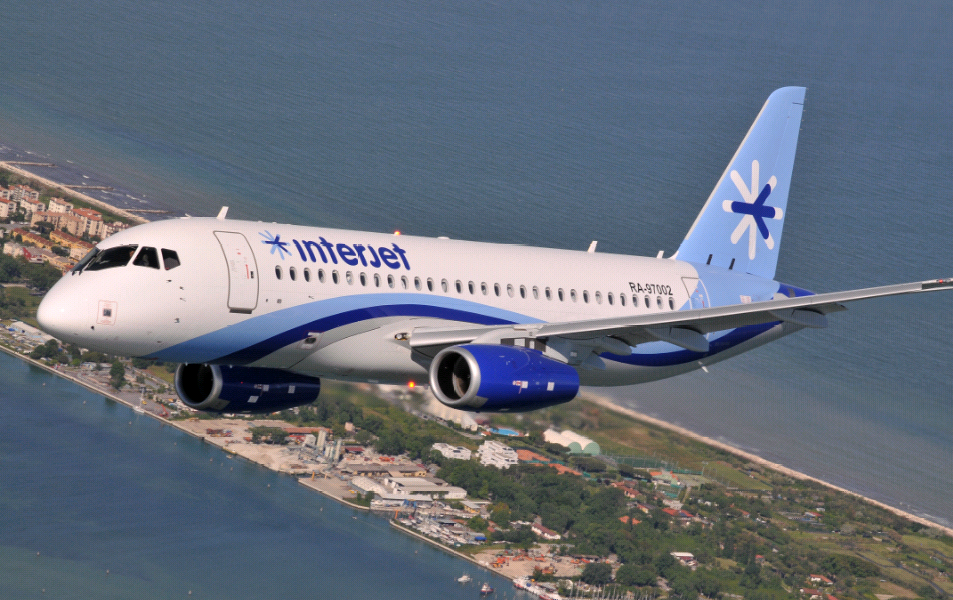Leeham News and Analysis
There's more to real news than a news release.
 Leeham News and Analysis
Leeham News and Analysis
- A350-1000 or 777-9? Part 3 April 25, 2024
- Boeing CEO promises company is turning around…again April 24, 2024
- Solid start for stand-alone GE Aerospace despite cuts to LEAP output April 23, 2024
- SPEEA, Boeing at impasse over safety program, union says April 23, 2024
- Better transparency needed on Boeing’s 1Q earnings call April 22, 2024
Welcome news for Bombardier, Mitsubishi
Subscription required
Introduction
 Feb. 22, 2016, © Leeham Co.: The large order (Letter of Intent) last week by Air Canada for 45 firm and 30 option CS300s was welcome news for Bombardier.
Feb. 22, 2016, © Leeham Co.: The large order (Letter of Intent) last week by Air Canada for 45 firm and 30 option CS300s was welcome news for Bombardier.
And the LOI from the US lessor, Aerolease, for 10+10 MRJ90s was welcome news for Mitsubishi.
We take a look at both announcements and what this means for the two programs.
Summary
- The Air Canada order breaks the long drought in C Series orders, but it’s not enough for smooth sailing (to mix metaphors) for the aerospace company.
- Continuing the mixed metaphor, Bombardier still has a long hill to climb.
- MRJ order, by little known lessor, helps diversify customer base.
Posted on February 22, 2016 by Scott Hamilton
Rolls-Royce, short and long term outlook
By Bjorn Fehrm
Subscription required.
Introduction
Feb. 18, 2016, ©. Leeham Co: Rolls-Royce reported earnings for the full year results for 2015 Friday. The share price took a hike after more than one and a half years of being pressed down by bad news.
There was nothing really new that was presented last Friday, with revenue of £13.4bn and profits before tax of £1.4bn. Both results were within the market’s expectations. It was rather the lack of more bad news that made the stock soar to a new high.
We now go behind the scenes to analyze why the stock is depressed and if this is a long term state for Rolls-Royce.
Summary:
- Rolls-Royce has delivered one bad news after the other since May 2014.
- The causes behind the bad news have varied between challenges in its Marine business to more competition and lower deliveries for its best-selling Civil Aerospace engine, the Trent 700.
- Rolls-Royce has also been criticized for boxing in of customers with its after-market TotalCare maintenance program. We describe what has changed and how this affects the situation.
- The company is also facing some accounting standard changes with the introduction of IFRS 15 for 2018. We discuss what consequences this might have.
Posted on February 18, 2016 by Bjorn Fehrm
Bombardier earnings preview
Subscription required
Introduction
Feb. 16, 2016, © Leeham Co.: Bombardier’s fourth quarter and full year 2015 financial results will be reported Wednesday, and we don’t expect the situation to be pretty.
Wednesday, and we don’t expect the situation to be pretty.
Yes, officials will highlight the recent closing of the sale of 30% of the Transportation (Rail) subsidiary.
Yes, the C Series is now on a world tour and appearing at the Singapore Air Show this week.
Yes, the CS100 will enter service in the second quarter.
Yes, the CS300 should be certified, delivered and enter service before the end of this year.
But missing will be any concrete information about new orders.
Summary
- Still no C Series orders since September 2014.
- Bombardier has its hand out for more government aid.
- ATR is making a new push in China and North America, the latter a stronghold for the Q400.
Posted on February 15, 2016 by Scott Hamilton
Can the 787 pay its debts?
By Bjorn Fehrm
Subscription required.
Introduction
04 February, 2015, © Leeham Co: Boeing has presented its results for the last quarter of 2015. It was a quarter for Boeing with solid performance in revenue ($96.1bn) and in cash generation ($9.4bn).
Despite that, Wall Street was not pleased. The 747-8 program is not selling well and the upcoming production bridges for 737NG to 737 MAX and 777 to 777X are no longer to be ignored.
The results presentation is also our chance to check our analysis around the 787 program; will it be able to pay its debts within the forecasted period by Boeing (in the program accounting block of 1,300 units)?
Summary:
- Boeing reports deferred costs in line with or slightly better than expectations. We decode what this means for the deferral curve for the 787 and from which parts of the 787 program the improvements came.
- Smith also gave new information regarding learning effects for 787-8 and 787-9 and when the 787 goes cash positive. We check if this changes any of our assumptions for our forecast for the program. Read more
Posted on February 4, 2016 by Bjorn Fehrm
A380 order welcome, but may not add to Airbus backlog
Subscription Required
Introduction
The news of orders by Iran Air and ANA for 12 and three A380s respectively is good news for Airbus, but  these probably don’t do much to boost the backlog in practical terms.
these probably don’t do much to boost the backlog in practical terms.
These orders will likely replace some of those in the A380 backlog that are unlikely to be delivered.
In our annual examination of the backlogs of Airbus and Boeing, little has changed for the A380—until the Iran Air and ANA orders, there hasn’t been a sale of the A380 in more than two years.
Summary
- As deliveries continue, the backlog shrinks.
- Orders from Virgin Atlantic are deferred and unlikely to be delivered. Look for a swap to another Airbus aircraft.
- Amedeo has yet to place any of its orders. First deliveries in 2017.
- Air Austral orders deferred, unlikely delivery.
Posted on February 1, 2016 by Scott Hamilton
Worry over Boeing 737 production rate ramp up overblown
Subscription Required
Introduction
Jan. 27, 2016, © Leeham Co. As Airbus prepares to hike production rates of the A320 family to 60/mo by the end of the decade and Boeing mulls whether to boost 737  rates above the announced 57/mo announced today, some question whether the companies should do so.
rates above the announced 57/mo announced today, some question whether the companies should do so.
The questions become more frequent as falling fuel prices make the need for the fuel efficient A320neo and 737 MAX appear to be less compelling. The economic turmoil in China adds to uncertainties.
Today we take a look at the 737 order book, based on Dec. 31 data, and extrapolate this to announced and potential future production rate hikes, and draw conclusions whether the rates announced and those under study make sense.
We will look at the A320 backlog in a future post.
Summary
- Looking at firm orders only with actual delivery dates shows minor production gaps.
- Large MAX TBD, unidentified customers make drawing firm conclusions difficult.
- Options and LOIs from solid customers show some years oversold.
Minuscule demand for Boeing 747-8F
- See Scott Hamilton’s new column for Forbes on-line, It’s time for hard questions for Boeing.
Subscription Required
Introduction

One of Boeing’s white tail 747-8Fs. This, and another that has been stored, was painted in the livery of the Seattle Seahawks. Boeing photo.
Jan. 25, 2016, © Leeham Co. Boeing’s decision to cut the production rate on the 747-8 is not a surprise. It’s only a surprise that it took officials so long to do so.
The company continues to cling to the hope of a recovery in the global air cargo market to sustain the program. This is unlikely, however.
The business case for the 747-8F is minuscule.
Summary
- The metrics of the global freight market have simply changed too much.
- Load factors for freight remain stuck below 45%.
- Yields continue to be low.
- Shifting trends from main deck freighters to using lower deck space on the big passenger airlines continues to grow.
- Low fuel prices, temporary though they may be, diminish the new for new 747-8Fs.
- Low capital cost 747-400 Passenger models stored in the desert or soon to be exiting the world’s fleet, along with stored 747-400Fs, provide ample opportunity for cheap freighters.
Posted on January 25, 2016 by Scott Hamilton
Analysis: Sukhoi’s regional jet SSJ100, Part 2
By Bjorn Fehrm
Subscription required
Introduction
21 January 2016, ©. Leeham Co: The first part of our analysis, published Monday, looked at Russia’s first effort to design and aircraft to penetrate the Western airplane market, Sukhoi Superjet (SSJ100). We concluded that the SSJ100 regional airliner was a good effort.
The aircraft was essentially a Russian airframe with Franco-Russian engines, Western systems and Western avionics. For aircraft that are delivered to Western airlines, it also has an Italian-designed/produced interior.
The aircraft has been in successful deployment with Interjet of Mexico and has now been ordered by CityJet of Dublin. After having looked at base characteristics of the aircraft/engine and also analysed the fuel consumption, we now continue with developing the Cash and Direct Operating Costs of the SSJ100. We compare it with the market leader in the 100 seats regional market, Embraer’s E190.
Summary:
- The SSJ100 is competitive on fuel costs compared to the E190.
- Maintenance costs for SSJ100 is still hard to predict as there is still too limited operational experience.
- Capital costs are lower for the SSJ100. This means that Direct Operating Costs, DOC, are attractive for the SSJ100.
Posted on January 21, 2016 by Bjorn Fehrm
Analysis: Sukhoi’s regional jet Superjet 100
By Bjorn Fehrm
Subscription required
Introduction
18 January 2016, © Leeham Co: Russian aircraft have never succeeded in penetrating the Western market. But then they never really tried, until now. They were designed for the Soviet Union captive market, including the partner states that historically participated in or were friendly to the communistic system. One comes to think of China, Egypt, Libya, Cuba and Nicaragua. The Sukhoi Civil Aircraft Company (SCAC) Superjet 100 (SSJ100) is the first Russian aircraft specifically designed from the outset to compete on a world market.
The Sukhoi Civil Aircraft Company (SCAC) Superjet 100 (SSJ100) is the first Russian aircraft specifically designed from the outset to compete on a world market.
We analyse its basic design and performance in comparison to the market leader in 100 seat regional flying, Embraer’s E190.
Summary:
- The SSJ100 is a half a generation younger design than the Embraer E190. It has modern aerodynamics, IMA-based modular avionics and an advanced Fly-By-Wire system.
- The feedback-based Fly-By-Wire enables a tight aircraft design with low wetted areas.
- The SSJ100 engines, SaM146, can best be described as a shrinked and cleaned up CFM56. They have the efficiency level of the E190’s CF34-10E.
- The aerodynamics and engines combine to give the SSJ100 a single digit edge in fuel burn over the E190.
Posted on January 18, 2016 by Bjorn Fehrm
Email Subscription
Twitter Updates
My TweetsAssociations
Aviation News-Commercial
Commentaries
Companies-Defense
Resources
YouTube
Archives
- April 2024
- March 2024
- February 2024
- January 2024
- December 2023
- November 2023
- October 2023
- September 2023
- August 2023
- July 2023
- June 2023
- May 2023
- April 2023
- March 2023
- February 2023
- January 2023
- December 2022
- November 2022
- October 2022
- September 2022
- August 2022
- July 2022
- June 2022
- May 2022
- April 2022
- March 2022
- February 2022
- January 2022
- December 2021
- November 2021
- October 2021
- September 2021
- August 2021
- July 2021
- June 2021
- May 2021
- April 2021
- March 2021
- February 2021
- January 2021
- December 2020
- November 2020
- October 2020
- September 2020
- August 2020
- July 2020
- June 2020
- May 2020
- April 2020
- March 2020
- February 2020
- January 2020
- December 2019
- November 2019
- October 2019
- September 2019
- August 2019
- July 2019
- June 2019
- May 2019
- April 2019
- March 2019
- February 2019
- January 2019
- December 2018
- November 2018
- October 2018
- September 2018
- August 2018
- July 2018
- June 2018
- May 2018
- April 2018
- March 2018
- February 2018
- January 2018
- December 2017
- November 2017
- October 2017
- September 2017
- August 2017
- July 2017
- June 2017
- May 2017
- April 2017
- March 2017
- February 2017
- January 2017
- December 2016
- November 2016
- October 2016
- September 2016
- August 2016
- July 2016
- June 2016
- May 2016
- April 2016
- March 2016
- February 2016
- January 2016
- December 2015
- November 2015
- October 2015
- September 2015
- August 2015
- July 2015
- June 2015
- May 2015
- April 2015
- March 2015
- February 2015
- January 2015
- December 2014
- November 2014
- October 2014
- September 2014
- August 2014
- July 2014
- June 2014
- May 2014
- April 2014
- March 2014
- February 2014
- January 2014
- December 2013
- November 2013
- October 2013
- September 2013
- August 2013
- July 2013
- June 2013
- May 2013
- April 2013
- March 2013
- February 2013
- January 2013
- December 2012
- November 2012
- October 2012
- September 2012
- August 2012
- July 2012
- June 2012
- May 2012
- April 2012
- March 2012
- February 2012
- January 2012
- December 2011
- November 2011
- October 2011
- September 2011
- August 2011
- July 2011
- June 2011
- May 2011
- April 2011
- March 2011
- February 2011
- January 2011
- December 2010
- November 2010
- October 2010
- September 2010
- August 2010
- July 2010
- June 2010
- May 2010
- April 2010
- March 2010
- February 2010
- January 2010
- December 2009
- November 2009
- October 2009
- September 2009
- August 2009
- July 2009
- June 2009
- May 2009
- April 2009
- March 2009
- February 2009
- January 2009
- December 2008
- November 2008
- October 2008
- September 2008
- August 2008
- July 2008
- June 2008
- May 2008
- April 2008
- March 2008
- February 2008


Dissecting Boeing cost-cutting
Subscription required.
Introduction
Feb. 11, 2016, © Leeham Co. The news yesterday that Boeing is undertaking a new round of cost-cutting has been buzzing around management and labor circles for months.
of cost-cutting has been buzzing around management and labor circles for months.
LNC last year began hearing management at Boeing Commercial Airplanes would likely face personnel cuts of 10% to 15%. Cuts were expected within the marketing/sales departments, in part due to struggling sales of the 7-Series airplanes, sources told LNC.
The leading labor unions, SPEEA (engineers) and IAM 751 (touch labor), each told LNC last year they expected workforce layoffs were in the future.
More ominously, a consultant who occasionally worked with Boeing, told LNC that the elevation of Dennis Muilenburg from president and chief operating office to president and CEO (and, eventually, chairman) would make former CEO Jim McNerney’s cost- cutting efforts pale by comparison.
Summary
Discussion Read more
Leave a Comment
Posted on February 11, 2016 by Scott Hamilton
Airbus, Boeing, IAM 751, Leeham News and Comment, Premium, SPEEA
737-10, 757, 777X, A330, Airbus, Boeing, Dennis Muilenburg, IAM 751, Jim McNerney, KC-46A, Ray Conner. 787, SPEEA, Wall Street Journal